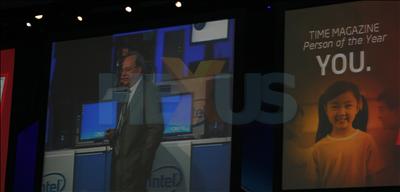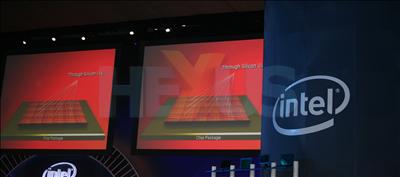
 Click for larger image
Click for larger imageKicking off the first official day of IDF2007, Justin Rattner, Intel's CTO, effused on how the Chinese people have been great innovators in the past and will continue to be so in the future. Intel, he commented, wants to be an integral part of the Chinese technical revolution and has already invested over $200m in burgeoning companies via the Intel capital fund. His initial comments resonated with the usual language used by companies looking not to 'annoy' the Chinese government in any way, shape or form. China, after all, is a positive goldmine and a huge source of potential future revenues.
Rattner regaled us by informing the gathered folk that Core 2 Duo was a fantastic launch last year, with a top-to-bottom release schedule. Intel, he beamed, shipped 135,000 server and 165,000 desktop quad-core processors in 2006, and expects to ship a million quad-core parts this year. Big numbers indeed.
Rattner routinely trotted out senior executives from China's leading IT companies which leverage Intel technology and, predictably, all were ecstatic with the extra performance afforded by the Core microarchitecture, be it server, desktop, or mobile-based.
Talking numbers again, Intel shipped 112m processors based on the mature 65nm process technology, first launched in 2005, and 94 per cent of shipments in Q2 2007 are expected to be based on this process, Rattner pointed out.
Intel's CTO then moved on to discussing the undeniable merits of the 45nm Penryn architecture, but rather than regurgitate what we've written in detail before, head on over to here for our technical take.
Looking towards the future, we were informed that Intel plans to sustain technology cadence (the new watchwords in the IT world, incidentally). In plain English, Intel plans to release a new processor architecture every two years and a speed/features bump in intervening years.
Swiftly moving on to production, Intel currently has seven factories churning out 300mm wafers, we were told. The eighth will be the Dalian plant (Fab 68) in China, setting Intel back around $2.5bn, covering 1,7m sq. feet, and will employ 1,500 eager people. Pretty exciting stuff!
JR was particularly keen to stress that Intel was architecting for energy efficiency. He mentioned that an ultra-low voltage Core 2 Duo-derived SKU will be launched later this year. Designing low-power CPUs is only one part of the energy-efficient jigsaw. In that context, Intel, in particular, is investing in research regarding solid-state (NAND-based) discs and phase change memory. Speaking excitedly, Rattner reckoned that phase change memory had the potential to replace DRAM. More on this tech. later on in the week.
 Click for larger image
Click for larger imageWrapping up, the inimitable JR delineated how Intel's tera-scale processors (and we're talking about a potential 80 cores here) could suffer from a lack of memory bandwidth, as each core requires its own throughput for optimal performance. As a solution to this, Intel is investing in a new technology - through silicon via - which 'stacks' DRAM chips right on to the various cores via a bonding process. Again, more on this as we quiz Intel's engineers around a round table (it could be square).
What can we take from JR's presentation? Well, Intel loves China and that feeling seems to be reciprocal. Core 2 Duo is great and will get better, and expect more innovation to come out of China. What about things we didn't know? Phase change memory and DRAM bonding on multi-core processors, which were both only hinted at, seem to be interesting, and we'll be covering it in more detail later.













